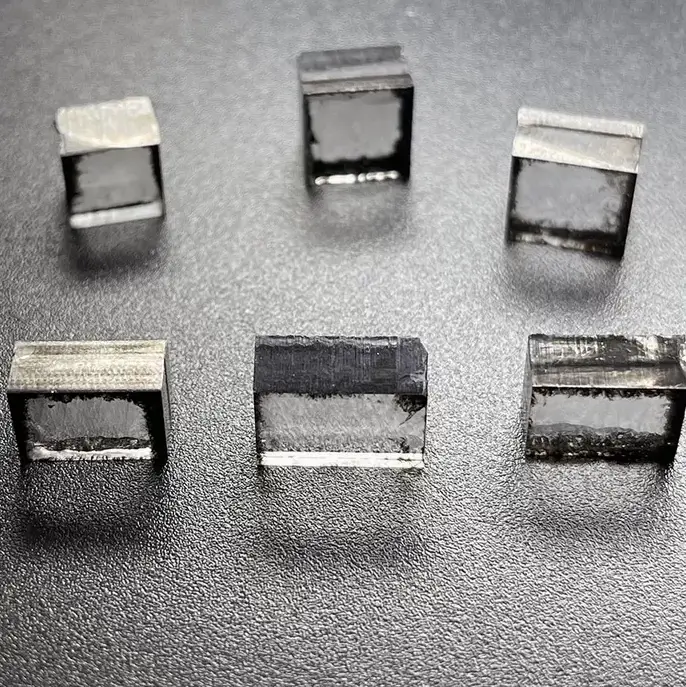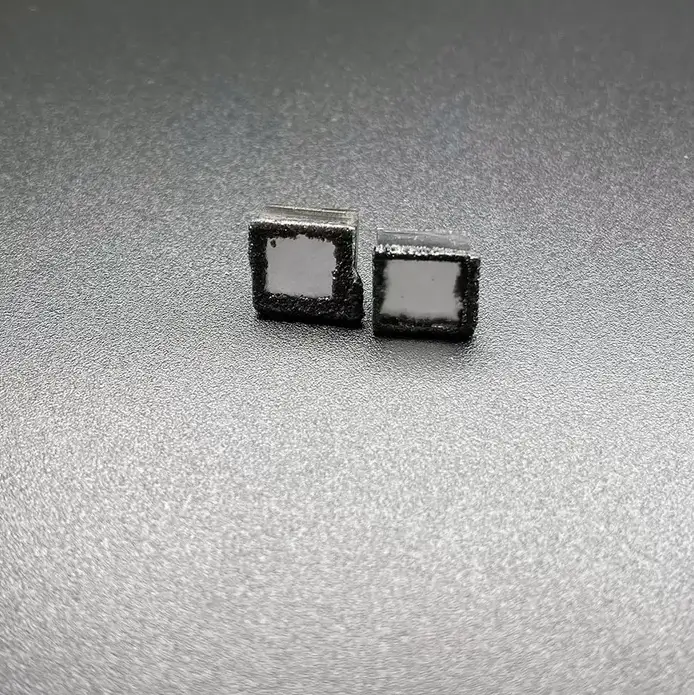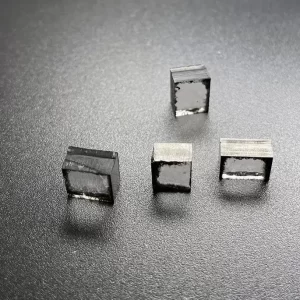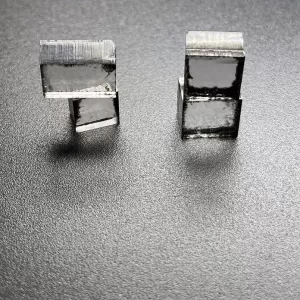VS SI 3.0ct 4.0ct 5.0ct CVD Rough Diamonds Custom For 1 Carat Loose Diamond
Vs Si Purity 3.0ct – 5.0ct CVD Rough Diamonds For 1 Carat Loose Cvd Diamond Cutting
CVD Rough Diamonds Description
Lab created diamonds can be made by HPHT and CVD methods.
What CVD stands for?
Chemical vapor deposition (CVD) is a process in which the carbon containing gas is dissociated and the carbon atoms are deposited on the substrate to form diamond films.
Diamond crystals grown by CVD are mostly plate-shaped, and occasionally small octahedral faces and diamond dodecahedral faces can be seen at the edge. The color of early CVD diamonds is dark brown or light brown, while recently discovered CVD diamonds have been proved to be colorless or nearly colorless after high temperature heat treatment. There are few inclusions in CVD diamonds, some of which are needle like and black irregular. However, it can not be used as a basis for distinguishing natural diamonds from HTHP synthetic diamonds. There is no metal inclusion in CVD diamond, so it is not magnetic.
Although the laboratory-grown rough diamonds are grown in the laboratory, they are composed of carbon atoms, have the same physical properties and chemical composition as natural diamonds, and have fewer impurities and higher purity than natural diamonds. And it’s cheaper.
CVD Rough Diamonds Custom For 1 Carat Loose Diamond
Lab-grown diamonds are an ethical and popular new alternative to conventional diamonds. They are also widely affordable. Before purchasing a diamond, it is wise to understand how CVD diamonds are made. Read on to learn more about the benefits of this alternative to loose diamonds. You should also understand the difference between GIA and IGI certifications. Here are some of the most common differences between the two:
GIA
Lab grown diamonds are a fantastic alternative to mined ones. These diamonds are able to meet the same high standards of natural diamonds and come accompanied with the same type of Diamond Grading Reports. The GIA and IGI have long held the market when it comes to grading man made diamonds, but there are other reputable labs as well.
While a large portion of CVDs are naturally colored, the majority are treated to remove the brown color. This treatment can remove or mask many of the diamond’s signature features, but it may not give the diamond its original color. The GIA says that about 70 percent of these diamonds have a noticeable brown tint. When they come out of the growing chamber, growers use a substance called HPHT to remove the color. HPHT is stable and does not change the diamond’s color over time. The HPHT treatment can also be exposed to a steam cleaner or jeweler’s torch. In addition, it does not affect the diamond’s clarity or cut quality. The post-growth treatment will be noted on the grading report and will not affect the diamond’s size or shape.
The best way to differentiate between natural and lab-grown diamonds is to look for phosphorescence. Diamonds exposed to UV light glow a different color when removed from the source. This cool effect is known as phosphorescence, and is an important feature to note when comparing stone quality. This phenomenon is common in natural and HPHT-grown diamonds, but it is rare with CVD stones. Some stones are unable to display phosphorescence and do not have the grading report.
When choosing the best diamond for your ring, remember that you’ll likely be paying a lot more for a round diamond than a diamond in another shape. Round diamonds are expensive because they lose more rough material during the cutting process. However, diamond cutters focus on the perfect cut, preserving weight, and the threshold, not the shape. It is important to remember that diamonds with a high-quality cut will require the highest quality cutters in the industry.
The carat weight is a measurement of diamond weight. One carat is equal to 200 milligrams, and five carats equals one metric gram. The higher the carat weight, the more expensive it is. And diamonds over five carats are rarer than smaller ones. But even these stones are still cheaper per carat, but you may not get the perfect one.
There are several benefits to buying lab-grown diamonds. While these diamonds are much cheaper than their natural counterparts, you’ll enjoy more clarity and color. They are also more easily scaled and are less costly. Choosing between the two is entirely up to you. If you’re on a tight budget, lab-grown diamonds may be the way to go.
IGI
Wholesalers all over the world sell loose diamonds of various carat weight and qualities. They can fit any budget and can be set in a number of jewelry pieces, including engagement rings. They can also be used for investment purposes. Buying a loose diamond allows you more flexibility in designing and choosing the jewelry that suits your needs. You can also opt to keep the diamond for future use, as it will not lose its original cut and color.
If you’re looking for a diamond with the highest value, you’ll want to select one with an F-I color grade and SI1 clarity. Buying diamonds outside these ranges will give you more options and allow you to control the price. You can choose to purchase diamonds with any color and clarity, as long as the total weight doesn’t exceed a particular threshold.
Most CVD diamonds come out of the growing chamber with a brown tint. To remove this color, growers apply a chemical called HPHT to the diamond. HPHT is stable and will not affect the diamond’s color over time. It can be removed with a jeweler’s torch or a steam cleaner, but it will not change the original color. A CVD diamond’s grading report will indicate whether it has undergone a Post Growth treatment.
Lab-grown diamonds are also graded like natural diamonds. The girdle of the diamond will have a unique inscription identifying its quality. You can identify these diamonds using a 50x magnification. When buying a diamond, make sure the retailer you’re purchasing from has a trusted return policy and guarantees the diamond is real. Always check the certificate of the diamond before buying.
You can also choose between a loose diamond and a cut diamond. Although the price difference is significant, the cut and color of a diamond is not always obvious. You can even buy loose diamonds with less quality if you want a large diamond that is easier to cut and polish. It is possible to find a diamond with lower quality than the one you want, and both options will be equally beautiful.
While it is true that HPHT diamonds can be slightly blue, it is due to boron impurities. Boron is an ingredient in fancy blue diamonds. HD videos and images of diamonds created through these processes are an excellent way to understand the differences between these diamonds and natural ones. The technology to grow lab-grown diamonds is constantly improving, so that they are becoming increasingly more affordable.
A lab-grown diamond, also known as a “ruby”, has the same chemical properties as natural diamonds. As such, they do not require destructive mining practices and conflict-ridden environments. They are also made from a variety of other substances, including white sapphires and zircon. They are also much harder to spot than natural diamonds.
Although these synthetic diamonds have the same appearance and chemical make-up as natural diamonds, they differ greatly in their inclusions. Natural diamonds are formed in the Earth’s crust. By contrast, lab-grown diamonds were created in a lab. As a result, CVD diamonds often contain inclusions of non-diamond carbon. Because of these differences, even the most experienced gemologist cannot tell the difference between these two types of diamonds with a magnifying glass or microscope.
VS SI 3.0ct 4.0ct 5.0ct CVD Rough Diamonds Custom For 1 Carat Loose Diamond
















